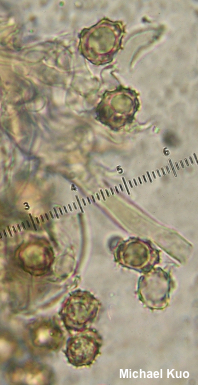| Major Groups > Clubs & Corals > Thelephora palmata |

|
[ Basidiomycota > Thelephorales > Thelephoraceae > Thelephora ... ] Thelephora palmata by Michael Kuo, 5 October 2022 Thelephora palmata is a European and North American coral mushroom recognized by its association with conifers, its dark colors at maturity, its flattened mature branches—and, especially, by its foul odor. The odor is reminiscent of fetid garlic or rotting cabbage, depending on which source you consult. My friend Hoa, who collected the mushrooms described and illustrated here, says Thelephora palmata smells like "radishes, cauliflower, and farts." Compare Thelephora palmata with Thelephora anthocephala, which is smaller, has branches that are less flattened, and is associated with hardwoods. Thanks to Hoa Pham for documenting, collecting, and preserving Thelephora palmata for study; her collection is deposited in The Herbarium of Michael Kuo. Description: Ecology: Mycorrhizal with conifers; growing alone or gregariously, on the ground; summer and fall; originally described from Carniola (in present-day Slovenia); widespread in Europe and North America. The illustrated and described collection is from Colorado. Fruiting Body: A branching structure 4–10 cm across and 3–10 cm high, with branches arising from shared stem structures. Branches: Numerous; individually cylindric at first, but becoming flattened with development; surface becoming slightly wrinkled; at first whitish, becoming brown to dark purplish brown. Stem: Hard to define precisely, but generally about 2–3 cm high and up to 0.5 cm thick; tough; dark gray to black; united with other stems basally. Flesh: Stringy; fairly tough; brownish to whitish; unchanging when sliced. Odor: Strong and foul (see discussion above). Chemical Reactions: KOH instantly black on all surfaces and flesh. Microscopic Features: Spores 8–11 x 6–8 µm (excluding ornamentation); vaguely ellipsoid to more or less subglobose—occasionally slightly lobed; covered with spines about 1 µm wide at the base, extending 0.5–1 µm high; brownish in KOH. Basidia 40–70 x 6–10 µm; clavate to widely cylindric; 4-sterigmate. Cystidia not found. Hyphae of the hymenium 3–8 µm wide, brown in KOH. Tramal elements grayish green to bluish in KOH. Clamp connections present. REFERENCES: (G. A. Scopoli, 1772) E. M. Fries, 1821. (Burt, 1914; Corner, 1968; Phillips, 1981; Arora, 1986; Breitenbach & Kränzlin, 1986; Phillips, 1991/2005; Schalkwijk-Barendsen, 1991; Stalpers, 1993; Barron, 1999; Roody, 2003; McNeil, 2006; Miller & Miller, 2006; Trudell & Ammirati, 2009; Buczacki et al., 2013; Ramírez-López et al., 2015; Desjardin, Wood & Stevens, 2015; Siegel & Schwarz, 2016; Gminder & Böhning, 2017; Kibby, 2017; Woehrel & Light, 2017; Elliott & Stephenson, 2018; Læssøe & Petersen, 2019.) Herb. Kuo 08262202. This site contains no information about the edibility or toxicity of mushrooms. |
© MushroomExpert.Com |
|
Cite this page as: Kuo, M. (2022, October). Thelephora palmata. Retrieved from the MushroomExpert.Com Web site: http://www.mushroomexpert.com/thelephora_palmata.html |




